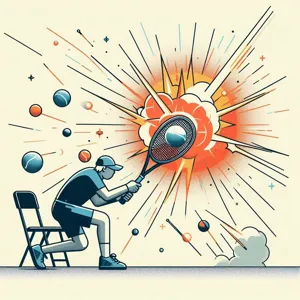In the world of tennis, the forehand is often regarded as the most potent weapon in a player’s arsenal.
Mastering this fundamental stroke can be the difference between a casual weekend match and a thrilling victory on the court. Whether you’re a novice eager to elevate your game or an experienced player looking to refine your technique, understanding the nuances of a powerful forehand is crucial. In this blog post, we will delve into the secrets behind unlocking your potential, exploring essential tips, drills, and strategies that can transform your forehand from a simple hit into a dominant force. From grip adjustments to footwork finesse, we’ll uncover the elements that contribute to a forehand that not only impresses but also intimidates opponents. Get ready to elevate your game and leave your mark on the court as we unveil the keys to mastering a powerful forehand!
1. Understanding the Forehand: The Foundation of Your Game

The forehand is often regarded as the cornerstone of a successful tennis game. It’s not just a stroke; it’s a powerful weapon that can dictate the pace of a match, control rallies, and even turn the tide in crucial moments. To truly unlock the potential of your forehand, it’s essential to understand its mechanics, variations, and strategic applications.
At its core, the forehand is an expression of both technique and timing. The stroke begins with a solid grip, commonly the Eastern or Semi-Western grip, which allows for optimal spin and control. As you prepare to hit, your feet should be positioned to facilitate efficient weight transfer from your back foot to your front foot, generating the power needed to send the ball soaring over the net. The follow-through is equally crucial; a smooth, full finish not only enhances your shot’s accuracy but also prepares you for the next play.
Moreover, mastering the forehand involves recognizing the importance of placement and spin. A flat forehand can be used to hit winners down the line, while a topspin forehand can push opponents back, giving you the advantage in a rally. Understanding when to use each variation is vital; it can keep your opponents guessing and create opportunities for you to control the game.
In addition to the physical aspects, mental preparation plays a significant role in executing a dominant forehand. Visualizing your shot, staying relaxed, and maintaining focus are all essential elements that contribute to your overall performance. As you develop your forehand, remember that practice is key. Hitting against a wall or practicing with a partner will help reinforce muscle memory and build confidence in your stroke.
By understanding the forehand’s foundational principles, you lay the groundwork for a versatile and aggressive game. As you refine this essential skill, you’ll find yourself not only improving your overall performance but also gaining the confidence to take charge of the court. So, grab your racket, focus on that forehand, and prepare to dominate your matches like never before!
2. Anatomy of a Powerful Forehand
To truly unlock the power of your forehand, it’s essential to understand the anatomy of this crucial shot. A powerful forehand is not just about brute strength; it’s a harmonious blend of technique, body mechanics, and timing.
**Grip**: The journey to a dominant forehand begins with the grip. The most commonly used grips for power are the Eastern and Semi-Western grips. These grips allow for maximum racquet face control, enabling you to generate both power and spin. Experiment with different grips to find the one that feels most natural and effective for your play style.
**Stance and Preparation**: Next comes your stance. A solid foundation is key. Position your feet shoulder-width apart and slightly bend your knees, ready to spring into action. As your opponent strikes the ball, pivot your hips and shoulders sideways, coiling your body like a spring. This preparatory phase is vital; it sets you up for the explosive movement that follows.
**Swing Path**: The swing path is where the magic happens. Start with a low-to-high motion, drawing the racquet back while keeping your eye on the incoming ball. As you initiate your forward swing, transfer your weight from your back foot to your front foot. This weight transfer, combined with a smooth, fluid motion, allows you to unleash your stored energy into the shot.
**Contact Point**: Timing is everything. Aim to make contact with the ball at waist height, slightly in front of your body. This optimal contact point not only maximizes power but also gives you greater control over placement. Keep your eye on the ball and focus on hitting it with the center of the racquet strings for a clean strike.
**Follow-Through**: Finally, don’t underestimate the importance of a proper follow-through. After contact, allow your racquet to continue its motion, finishing high above your shoulder. This not only enhances your shot’s power but also helps in maintaining balance and preparing for the next move.
By focusing on these key elements—the grip, stance, swing path, contact point, and follow-through—you can transform your forehand from a mere shot into a formidable weapon on the court. With practice and attention to detail, you’ll find that your forehand is not only powerful but also a reliable asset in your overall game strategy.
3. Grip Styles: Finding What Works for You

When it comes to mastering the forehand in tennis, the grip you choose can significantly impact your performance on the court. Grip styles are not just a matter of personal preference; they can dictate the trajectory, spin, and power of your shots. Finding the right grip is akin to unlocking a hidden power within your game.
There are several popular grip styles, each offering distinct advantages. The **Eastern grip**, for instance, is favored for its versatility, allowing players to generate a solid mix of power and spin. This grip, which involves placing the base knuckle of your index finger against the third bevel of the racket handle, encourages a more natural swing path and is ideal for flat shots. It’s a great starting point for beginners or those looking to refine their technique.
For players who crave more topspin, the **Western grip** might feel like the key to their success. This grip involves placing your palm further under the racket, giving you the leverage to whip the racket head upward through contact. The result? A high, heavy ball that can push opponents back and create opportunities for winning shots. However, it requires strong wrist control and timing, so practice is essential to wield this grip effectively.
Lastly, the **Semi-Western grip** strikes a balance between the Eastern and Western grips. It allows for a combination of power and spin, making it a popular choice among professional players. With the base knuckle on the fourth bevel, this grip enables players to hit with depth and control while still putting enough topspin on the ball to keep it in play.
Finding what works for you involves experimentation. Spend time on the court trying out different grips and pay attention to how your shots feel. Notice the differences in control, power, and spin with each style. It can also be beneficial to observe skilled players and see how their grip choices influence their game. Remember, there’s no one-size-fits-all solution; your grip should feel comfortable and natural, enhancing your forehand rather than hindering it.
Ultimately, developing a dominant forehand is about more than just technique; it’s about understanding how your grip sets the foundation for every shot. Embrace the journey of exploration, and soon enough, you’ll find the grip that unlocks your full potential on the court.
4. Stance and Positioning: Setting Up for Success
When it comes to executing a powerful forehand in tennis, the importance of stance and positioning cannot be overstated. These foundational elements set the stage for a successful shot, allowing you to unleash your full potential on the court.
Start with your feet shoulder-width apart, which provides a stable base of support. This balanced stance is crucial; it allows for quick lateral movements while maintaining your center of gravity. As the ball approaches, pivot on your back foot, allowing your body to rotate into the shot. This coiling motion not only generates power but also prepares your hips and shoulders to lead the swing.
Positioning is equally important. Always anticipate where the ball will land, allowing you to get into position early. Ideally, you want to meet the ball in front of your body—between your leading foot and your back foot—enabling you to hit it with full force. As you set up for the shot, ensure your non-dominant hand is extended forward, guiding your racket and helping to maintain balance.
Remember, the angle of your stance can significantly influence the trajectory of your shot. A slight open stance can be beneficial when facing a powerful opponent, as it allows for quicker recovery and movement after the shot. Conversely, a closed stance can be advantageous when you want to generate extra topspin or control.
Incorporating these principles into your training will not only enhance your forehand but also instill a sense of confidence on the court. With a solid stance and proper positioning, you’ll be well on your way to dominating with every swing.
5. The Role of Footwork in Generating Power

When it comes to mastering a dominant forehand in tennis, one of the most crucial yet often overlooked elements is footwork. Your feet are the foundation of your game, and their position and movement can significantly influence the power and accuracy of your strokes. Good footwork allows you to position yourself effectively to hit the ball at the optimal angle, making it easier to generate the explosive energy needed for a powerful forehand.
Imagine stepping onto the court: the moment the ball crosses the net, your body should be in motion, anticipating its trajectory. The first step is vital; a quick and agile movement towards the ball sets the tone for the entire shot. As you sprint to the ball, it’s essential to maintain a low center of gravity. This position increases your stability and allows you to load your legs for the impending shot. The more grounded you are, the more power you can transfer from your lower body through your core and into your arm.
As you prepare to strike, your feet should be positioned shoulder-width apart, providing a solid base from which to generate force. A common mistake is to become too upright, which can lead to a loss of balance and power. Instead, bend your knees slightly and stay on the balls of your feet, ready to spring into action. This athletic stance not only helps you maintain balance but also allows for quicker lateral movements, ensuring you can respond to your opponent’s shots effectively.
Once in position, the synergy between your footwork and swing is essential. As you initiate your forehand, pivot on your back foot to rotate your hips and shoulders. This movement creates a kinetic chain reaction that maximizes your shot’s power. The more you practice this coordination, the more instinctual it will become.
Incorporating footwork drills into your training routine can help improve your overall movement on the court. Exercises such as ladder drills, cone sprints, and shadow swings can enhance your agility and foot speed, allowing you to move swiftly into position for that powerful forehand. Remember, power doesn’t just come from your arm; it originates from the ground up. So, the next time you step onto the court, pay attention to your footwork—it could be the secret ingredient to unlocking your full forehand potential.
6. Key Techniques for a Dominant Swing
To truly master the forehand and unlock its full potential, focusing on key techniques is essential. A dominant forehand is not just about raw power; it’s about precision, timing, and fluidity. Here are some fundamental techniques to help elevate your game.
**Grip**: The foundation of a powerful forehand begins with the right grip. The semi-western grip is favored by many professional players because it allows for a comfortable blend of power and topspin. This grip enables you to hit the ball with both authority and control, ensuring that your shots remain consistent.
**Stance**: Your stance plays a pivotal role in generating power. Position your feet shoulder-width apart for balance, and adopt an open or semi-open stance. This alignment not only enhances stability but also allows your hips and shoulders to rotate effectively during the swing, adding momentum to your shot.
**Preparation**: As the ball approaches, early preparation is key. Turn your shoulders and pivot your non-dominant foot to face sideways to the net, getting your racket back well before the ball reaches you. This early movement allows you to gauge the ball’s speed and trajectory, setting you up for an effective swing.
**Swing Path**: A smooth, fluid swing path is crucial for generating power and spin. Start with the racket below the ball and accelerate through the contact point, following through high. This upward motion will not only impart topspin but also help in controlling the depth of your shots. Remember, your follow-through should be complete, with the racket finishing over your opposite shoulder, indicating that you have fully committed to the shot.
**Contact Point**: Striking the ball at the optimal contact point—typically around waist height—will significantly affect your shot’s power and precision. Focus on making contact slightly in front of your body, as this allows for greater control and leverage, enabling you to direct the ball where you want it to go.
By honing these key techniques—grip, stance, preparation, swing path, and contact point—you’ll be well on your way to developing a forehand that not only intimidates your opponents but also enhances your overall performance on the court. Practice diligently, and soon enough, you’ll find that your forehand becomes not just a stroke, but a weapon in your tennis arsenal.
7. Timing: The Secret to Striking the Ball Effectively

When it comes to mastering a dominant forehand in tennis, timing is the unsung hero that can make or break your performance on the court. It’s not just about swinging your racket at the right moment; it’s about synchronizing your body movement, racket speed, and ball contact in a fluid motion that maximizes power and precision.
The moment you see the ball coming your way, your mind should begin to assess its speed, trajectory, and spin. This split-second analysis allows you to position yourself optimally, preparing for that perfect strike. As the ball approaches, focus on your footwork—quick, small steps will help you get into the ideal stance. Remember, being in the right position is half the battle won.
As you prepare to hit, keep your eye on the ball. The key to effective timing is to watch the ball closely as it approaches, allowing you to gauge its distance and speed. A well-timed forehand is executed when the ball is at the peak of its bounce, giving you the best chance to hit it at a comfortable height and with full force.
Additionally, consider the rhythm of your stroke. A great forehand isn’t just about raw power; it’s about a smooth, rhythmic motion that flows seamlessly from your preparation to your follow-through. Practice the timing of your swing during drills; focus on finding that sweet spot where your racket meets the ball, producing a satisfying thwack that signifies a well-executed shot.
Incorporating timing drills into your training routine can also be beneficial. Use a ball machine or practice with a partner who can vary the speed and angle of their shots. This variability will force you to adapt your timing and develop a more instinctive feel for striking the ball effectively, ensuring you’re prepared when it counts during a match.
Ultimately, mastering the timing of your forehand will allow you to unleash your full potential on the court, turning your shots into powerful weapons that can dictate the pace of the game and keep your opponents on their toes. With practice and attention to this essential element, you’ll find that your forehand can become a formidable aspect of your tennis arsenal.
8. Follow-Through: Why It Matters for Power and Control
The follow-through is often an overlooked aspect of the forehand, yet it plays a crucial role in achieving both power and control in your shots. Many players focus solely on their swing and contact point, but neglecting the follow-through can result in a loss of energy and precision. A proper follow-through not only helps to transfer the accumulated energy from your body into the ball, but it also ensures that you maintain control over the direction and depth of your shot.
When executed correctly, your follow-through will allow your racket to finish high and in front of your body, which is essential for generating topspin. This upward motion helps the ball to dip quickly after crossing the net, giving your opponent less time to react. Additionally, a full and fluid follow-through promotes balance and stability, ensuring that you are well-prepared for the next shot.
As you practice your forehand, pay close attention to the trajectory of your racket after contact. Imagine it painting an arc in the air, as this imagery can help reinforce the importance of an extended follow-through. Not only does this technique enhance your power by maximizing the kinetic chain from your legs through your torso and into your arm, but it also cultivates a sense of rhythm and timing, essential for any successful tennis player.
Incorporating a deliberate follow-through into your practice routine can lead to significant improvements in your game. By focusing on this often-ignored element, you’ll unlock a new level of power and control, making your forehand a dominant weapon on the court.
9. Drills to Improve Your Forehand Technique
Improving your forehand technique is essential for dominating the court, and the right drills can make all the difference. Here are some effective exercises that can help refine your stroke, increase your power, and enhance your overall consistency.
**1. Shadow Swings:** Begin by focusing on your form without the pressure of hitting a ball. Stand in front of a mirror or use a video recording device to observe your stance, grip, and follow-through. Conduct slow, deliberate swings, emphasizing the smooth rotation of your hips and shoulders. This drill builds muscle memory and allows you to fine-tune your technique without distractions.
**2. Wall Rebounds:** Find a solid wall and practice hitting balls against it. Start with a moderate pace, focusing on your grip, footwork, and timing. As you gain confidence, increase your intensity and try to hit the ball with more power. This drill not only enhances your accuracy but also improves your reaction time, as you’ll need to adjust quickly to the ball’s return.
**3. Partner Drills:** Collaborate with a partner to perform cross-court rallies. Start at a comfortable distance and aim to consistently hit the ball to your partner’s forehand. This drill helps you practice your stroke under varying conditions while also improving your ability to anticipate the ball’s trajectory. Gradually increase the distance between you and your partner to challenge yourself further.
**4. Target Practice:** Set up targets on the court—these could be cones, hula hoops, or simply marked areas. During your practice sessions, aim your forehands at these targets. This drill enhances your precision and helps you learn to control the ball’s placement, an essential skill for outmaneuvering your opponents during matches.
**5. Progressive Drills:** Combine your forehand practice with movement. Start at the baseline and hit a forehand, then sprint to the net and hit a volley, followed by returning to the baseline for another forehand. This drill mimics match scenarios, allowing you to develop not only your technique but also your stamina and court coverage.
By incorporating these drills into your training routine, you’ll cultivate a powerful and reliable forehand that can dominate your opponents. Remember, consistency is key, so practice regularly, stay patient, and watch your forehand transform into one of your greatest assets on the court.
10. Mental Strategies for Confidence in Your Forehand
Developing a powerful forehand is not solely about physical technique; it’s equally about cultivating the right mindset. The mental game in tennis can make the difference between a consistent, dominating forehand and one that falters under pressure. Here are some strategies to bolster your confidence and elevate your performance on the court.
First, visualize success. Before stepping onto the court, take a moment to close your eyes and picture yourself executing the perfect forehand. Imagine the sound of the racket striking the ball, the feel of your body in motion, and the ball sailing over the net with precision. Visualization helps create a mental blueprint of success, reinforcing your belief that you can replicate that performance during a match.
Next, practice positive self-talk. The voice inside your head can either be your greatest ally or your worst critic. Replace negative thoughts — like “I always mess up my forehand” — with powerful affirmations such as “I have a strong forehand, and I can hit it with confidence.” Repeating these affirmations can help you build a more resilient mindset and reinforce your skills.
Additionally, develop a pre-shot routine. This could include a specific way you bounce the ball, a deep breath, or a focus on your target before hitting. A consistent routine not only prepares your body but also calms your mind, allowing you to enter your shot with clarity and purpose. It’s a moment to regroup and reaffirm your confidence, shifting your focus back to the task at hand.
Finally, embrace the power of resilience. Every player faces challenges, whether it’s an unexpected miss or a tough opponent. Instead of dwelling on mistakes, frame them as learning experiences. Understand that setbacks are part of the game and an opportunity for growth. By cultivating resilience, you’ll find that your confidence in your forehand strengthens, allowing you to approach each shot with a renewed sense of determination.
Incorporating these mental strategies into your practice will not only enhance your forehand but will also empower you to face each match with unshakeable confidence. Remember, the journey to mastering your forehand begins in the mind just as much as it does with your swings.
11. Analyzing Professional Players’ Forehands
To truly elevate your own forehand technique, there’s no better resource than the pros who dominate the sport. Analyzing the forehands of professional players offers invaluable insights into the mechanics, mindset, and strategic applications of this crucial stroke. Whether you’re captivated by the elegant fluidity of Rafael Nadal’s topspin-heavy shots or the explosive power of Roger Federer’s precise strikes, each player brings a unique style that can serve as a blueprint for your own game.
Begin by focusing on the fundamentals that underpin their success. Notice how they position their feet and prepare their bodies before making contact with the ball. The importance of a solid stance cannot be overstated; it serves as the foundation for balance and power. Observe the way they use their non-dominant hand during the stroke—this is critical for maintaining control and generating that explosive momentum.
Next, pay attention to their follow-through. A smooth, high follow-through can enhance the spin and depth of your shot, much like how Serena Williams or Novak Djokovic harness their body’s natural rotation to add velocity. By mimicking these follow-throughs, you can improve your own shot consistency and effectiveness.
Additionally, consider the tactical aspects of their forehands. Professional players don’t just hit the ball—they target specific areas of the court and anticipate their opponent’s movements. Take note of their shot selection; they often employ strategic variations, switching between power shots, heavy topspin, and slice to keep their opponents guessing. This level of tactical awareness can significantly elevate your game, transforming your forehand from merely a stroke into a potent weapon.
Incorporating these observations into your practice will not only refine your technique but also instill a deeper understanding of the forehand as a dynamic, multifaceted tool in your tennis arsenal. As you analyze and adapt, remember that mastering this stroke is a journey, and learning from the best is one of the most effective ways to unlock your full potential on the court.
12. Common Mistakes to Avoid for a More Powerful Shot
When it comes to harnessing the full potential of your forehand, recognizing and avoiding common mistakes can be the difference between a mediocre shot and a powerful, game-changing stroke. Here are some pitfalls to steer clear of as you work on your forehand technique.
**1. Poor Grip Choice:** One of the first missteps players often make is choosing the wrong grip. The semi-western grip is widely favored for its ability to generate topspin while maintaining control, but some players stubbornly cling to an outdated eastern grip. This can lead to inconsistent ball contact and a lack of power. Experiment with your grip and find the position that feels natural while allowing for maximum racket head speed.
**2. Lack of Footwork:** A powerful forehand starts with proper footwork. Many players fail to position themselves correctly, often rushing their shot or reaching for the ball out of their optimal range. This results in off-balance hits that lack the desired velocity. Focus on your footwork—take the time to set your feet and position your body correctly to ensure solid contact with the ball.
**3. Overreliance on Arm Strength:** While arm strength plays a role in generating power, relying solely on your arm can lead to fatigue and injury. Instead, engage your core and legs in the shot. A powerful forehand comes from a full-body movement, where your legs push off the ground and your hips drive the swing. This kinetic chain produces more energy and translates into a more formidable shot.
**4. Inconsistent Follow-Through:** A common mistake that can rob your forehand of its power is an incomplete follow-through. Many players either cut their follow-through short out of habit or are too eager to prepare for the next shot. This not only diminishes the power of the shot but can also lead to inconsistencies. Focus on a full, smooth follow-through that allows your racket to finish high, which aids in both accuracy and spin.
**5. Ignoring Ball Spin:** Understanding how to manipulate spin can enhance your forehand significantly. Many players neglect to apply topspin or underestimate its importance. Topspin not only adds depth to your shots but also allows for a more aggressive angle of attack. Practicing your topspin mechanics will give your forehand that extra kick, making it more difficult for opponents to return.
By being mindful of these common mistakes, you can refine your forehand technique and unlock the full potential of your shot. Remember, every small adjustment can lead to significant improvements in power, consistency, and overall performance on the court. Happy hitting!
13. Strength and Conditioning for Tennis Players
Strength and conditioning are pivotal components in mastering a dominant forehand in tennis. Unlike other sports, tennis demands a unique blend of explosive power, agility, and endurance. To truly elevate your game, you must focus not only on technique but also on enhancing your physical capabilities.
A well-rounded strength and conditioning program should target the key muscle groups involved in executing a powerful forehand. Begin with core exercises, as a strong core stabilizes your body during the rapid movements required on the court. Planks, medicine ball rotations, and Russian twists can help build this essential strength.
Next, prioritize lower body workouts. Squats, lunges, and deadlifts will not only increase your leg strength but also improve your ability to generate power from your legs, which is crucial when transferring energy into your shots. Remember, the forehand is not just about the arm; it’s about harnessing the full kinetic chain, starting from the ground up.
Don’t overlook the importance of agility and flexibility training. Incorporate drills that enhance your footwork and allow for quick changes in direction, such as ladder drills or cone sprints. Additionally, yoga or dynamic stretching routines can aid in maintaining flexibility and preventing injuries, ensuring that you can play at your best, match after match.
Finally, conditioning should also encompass cardiovascular fitness. Tennis matches can be grueling, often lasting several hours, so incorporating interval training or long-distance runs will boost your stamina, allowing you to maintain your performance level throughout the match.
Incorporating these strength and conditioning strategies into your training regimen will not only enhance your forehand power but also contribute to your overall performance on the court, ensuring you’re always ready to dominate your opponent with every swing.
14. How to Incorporate Your Forehand into Match Play
Incorporating your forehand into match play is not just about hitting the ball hard; it’s about strategically weaving this powerful shot into your overall game plan. To truly dominate on the court, you need to understand how to set up your forehand for success while also being aware of your opponent’s positioning and tendencies.
Start by recognizing the right moments to unleash your forehand. Look for opportunities when your opponent is out of position, or when they send you a high ball that sets you up perfectly for a strong, aggressive shot. The key here is to remain patient; don’t force your forehand if the situation doesn’t call for it. Instead, use your other shots—such as your serve, backhand, or volleys—to create openings and space on the court.
When you do take your forehand, focus on executing it with consistency and precision. Aim to hit with depth, targeting the corners of the court, which will stretch your opponent and potentially create a weak return. Additionally, mix up your forehand by incorporating different spins and angles. A well-placed topspin shot can push your opponent back, while a flat drive can catch them off guard and lead to a winning point.
Another effective strategy is to practice transitioning from your forehand into the net. After hitting a strong forehand, be ready to follow it up with an approach shot and move in for the volley. This not only puts pressure on your opponent but also allows you to take control of the point.
In match scenarios, always remember to read your opponent’s reactions. If they seem to struggle with your forehand, capitalize on that. Consistently using your forehand to dictate play can leave your opponent scrambling, giving you the upper hand in the match.
By incorporating these strategies into your match play, you’ll not only enhance your forehand but also develop a more well-rounded game that keeps your opponents guessing and on their toes. Ultimately, mastering the art of integrating your forehand effectively into your overall strategy can be the key to unlocking your full potential on the tennis court.
15. Conclusion: Consistency and Practice for Long-term Improvement
In the world of tennis, mastering a dominant forehand is not merely about raw power or explosive speed; it’s about the unwavering foundation of consistency and the relentless drive for improvement through practice. As we conclude this exploration into the secrets behind a formidable forehand, it’s crucial to remember that every great player has walked the path of repetition and refinement.
Consistency is the bedrock upon which all skills are built. It’s the ability to execute your forehand reliably, regardless of the pressure of a match or the unpredictability of your opponent’s play. This doesn’t just happen overnight. It requires hours on the court, diligently working through drills that reinforce your grip, stance, and swing. Regular practice sessions, where you focus on the mechanics of your forehand, will not only enhance your muscle memory but also instill confidence in your game.
Equally important is the mindset of continual improvement. Tennis is an evolving sport, and even the best athletes recognize that there’s always room for growth. Embrace each practice as an opportunity to learn—whether it’s analyzing your footwork, adjusting your follow-through, or developing the ability to hit with topspin or slice as needed. Recording your sessions, seeking feedback, or even working with a coach can provide invaluable insights that propel your game to new heights.
So, as you step onto the court, remember that a dominant forehand is not an end goal but a journey. Cultivating consistency through dedicated practice will not only enhance your forehand but transform you into a more formidable and confident player overall. With patience, perseverance, and a passion for the game, you can unlock the true power of your forehand and elevate your tennis performance to astonishing levels.
In conclusion, mastering a dominant forehand in tennis is not just about sheer power; it’s a combination of technique, precision, and mental focus. By incorporating the secrets we’ve discussed—from proper grip and footwork to consistent practice and strategic shot placement—you can unlock the full potential of your forehand and elevate your game to new heights. Whether you’re a beginner looking to build a solid foundation or an experienced player aiming to refine your skills, remember that persistence and dedication are key. So, gear up, hit the courts, and unleash your newfound forehand prowess! We can’t wait to see how these tips transform your game. Happy swinging!






